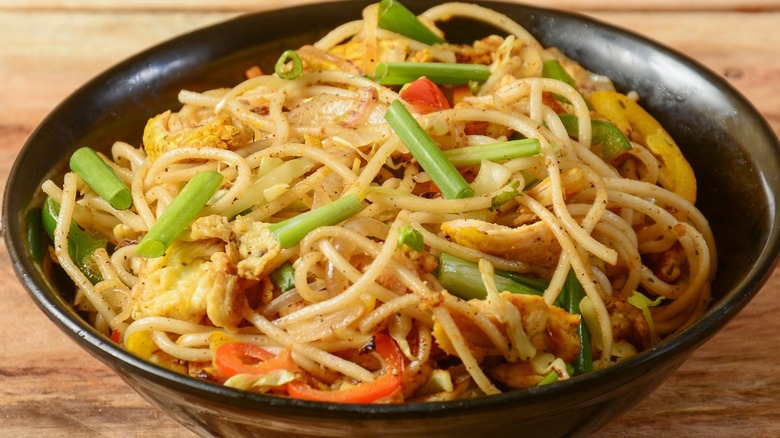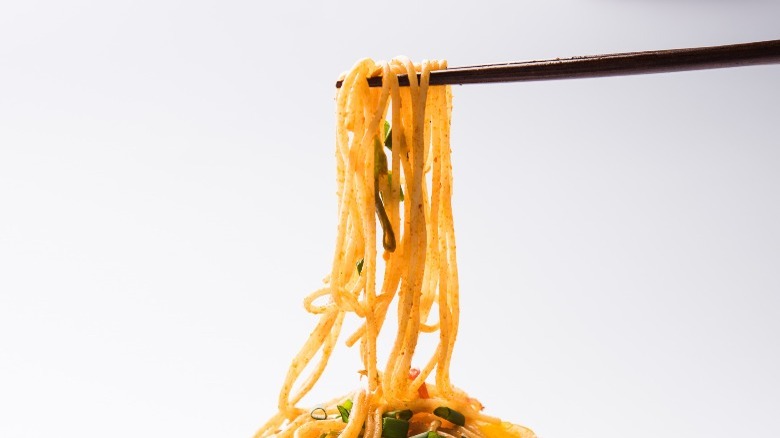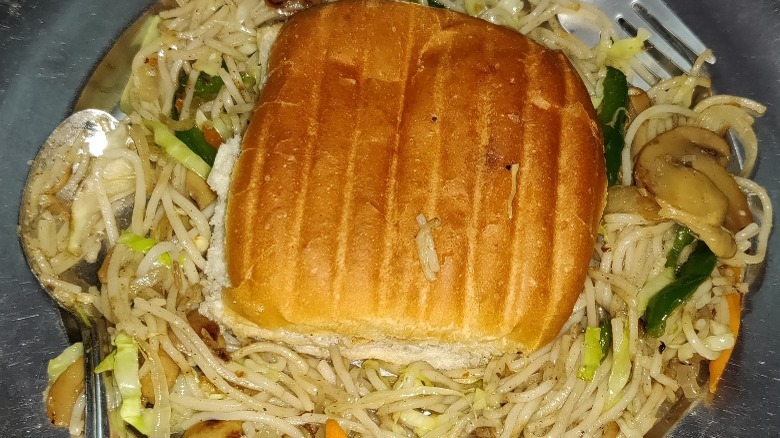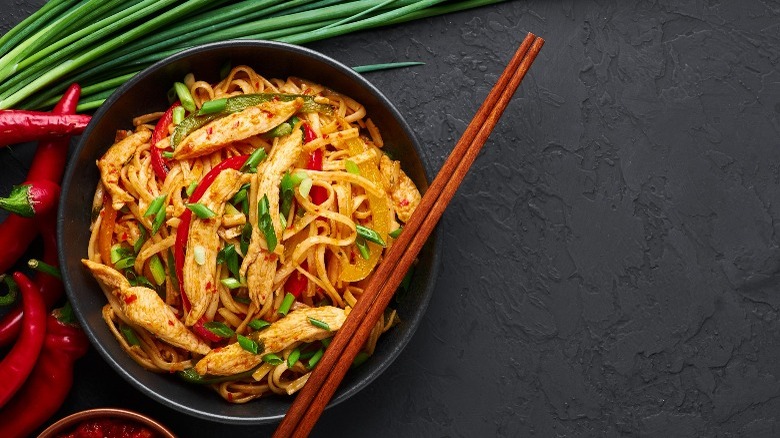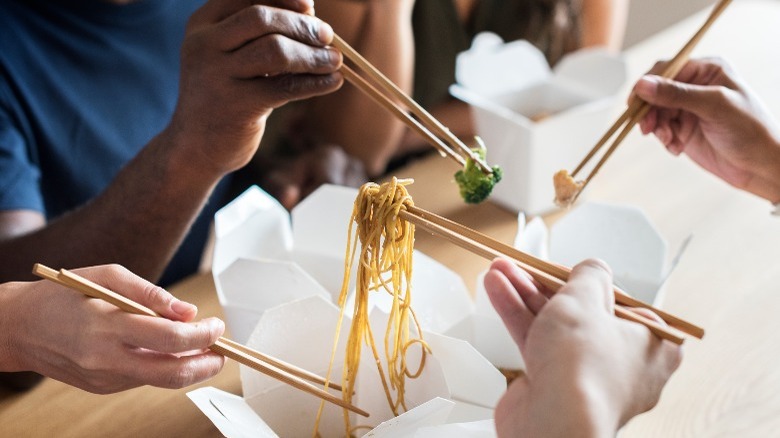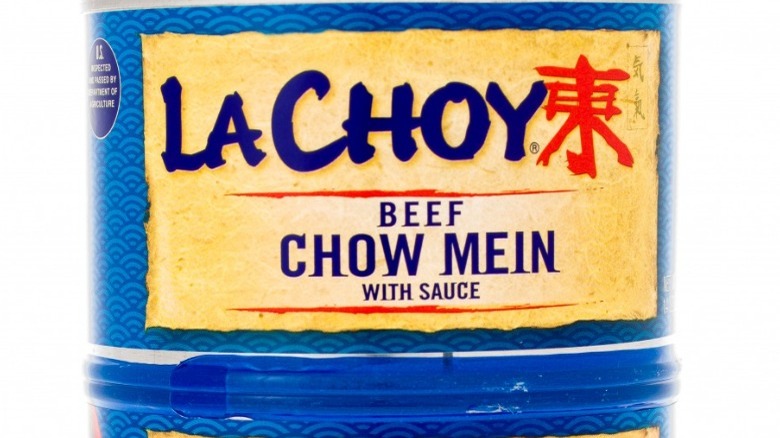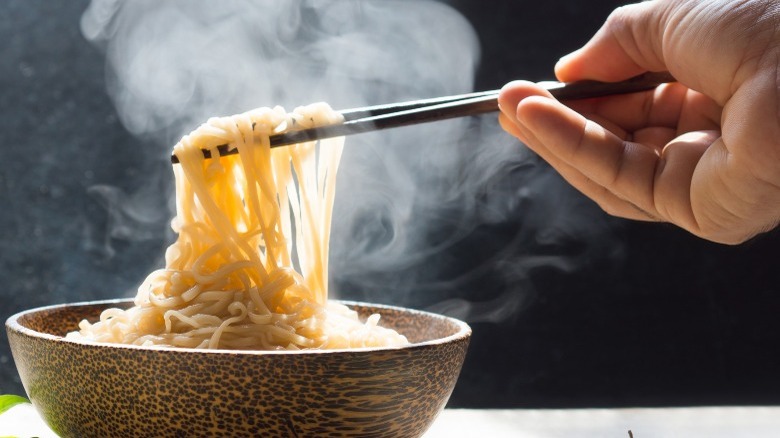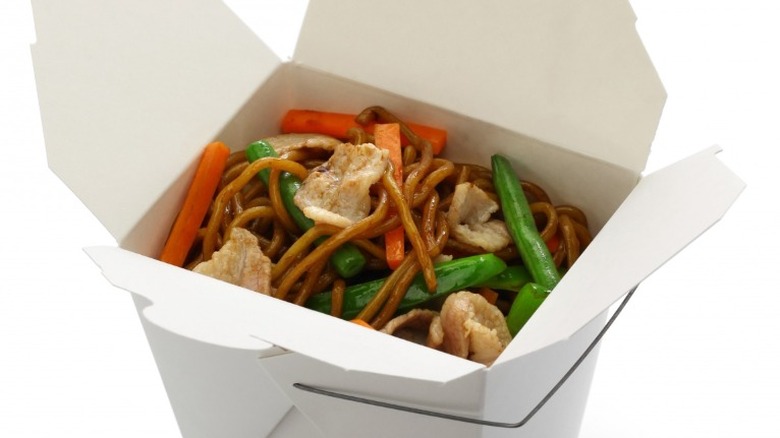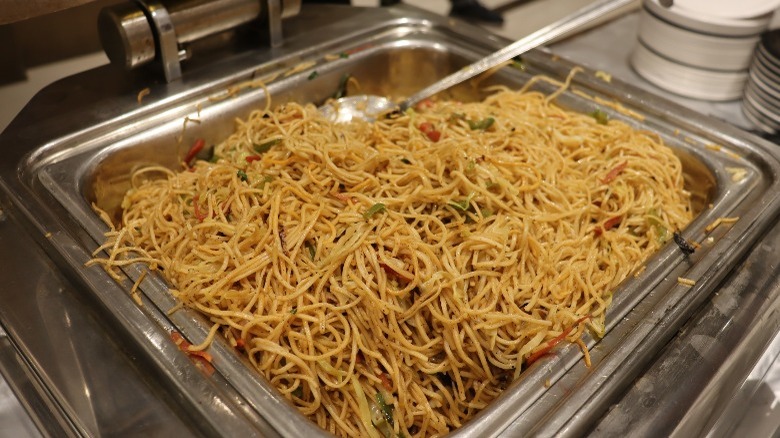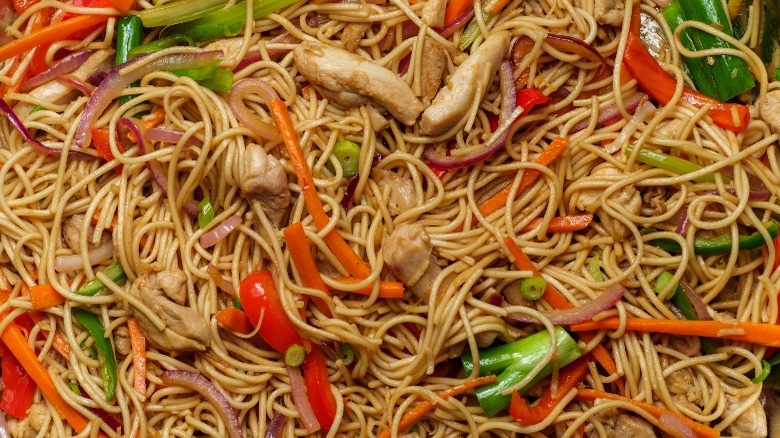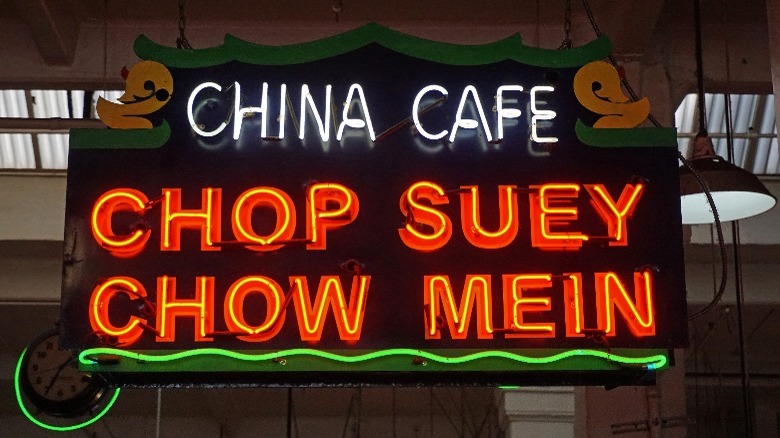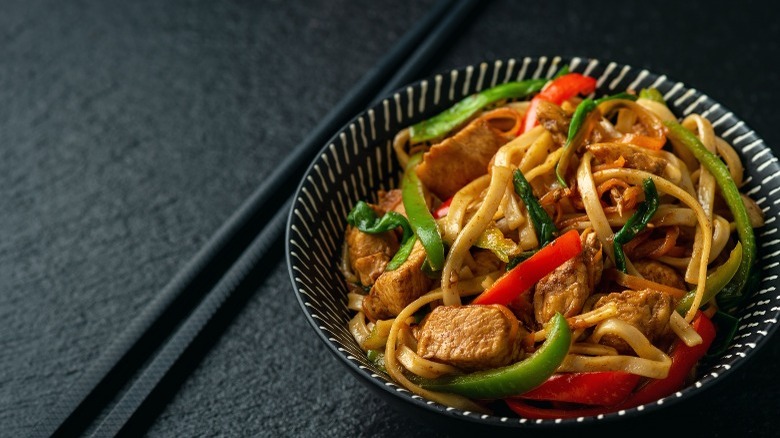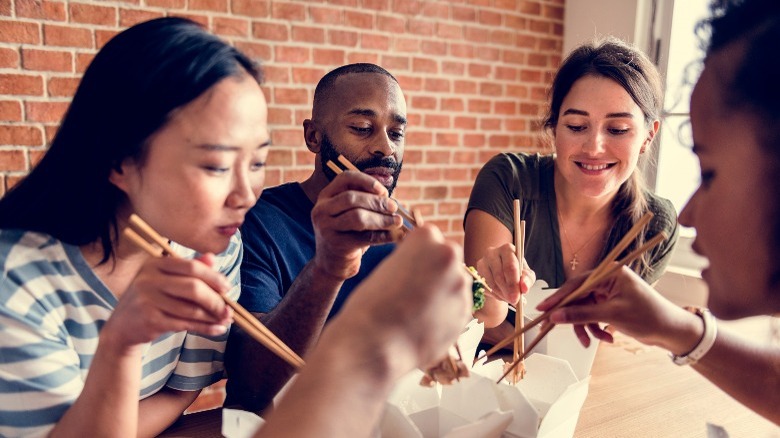The Untold Truth Of Chow Mein
This is a dish many people around the world find familiar, even if they've encountered it under different circumstances and different sauces. Some people may have met chow mein in school. While others found it in a street food cart, or discovered it in a take-out restaurant. Its crunchy noodles have taken on a life of their own. It's the kind of meal that shows up where you least expect it but doesn't always show up on menus you would expect to highlight chow mein. On top of all that, it comes with a heaping side of nostalgia.
Where did chow mein come from, and why isn't it on the menu anymore? Does it really come in a sandwich? This is a dish of many faces, and you may be surprised how long it's been cooking. Dive into a stir-fry of history, etymology, and politics as we explore the untold truth of chow mein.
The name means fried dough or noodles
Words are funny things. So are names, especially when they become popular across cultures. Some dishes have entire essays dedicated to their origins, but in chow mein's case, its route to Chinese-American restaurants is clear. Chow mein's roots in the Chinese mainland begin in the dish's name. It isn't inspired by the American slang for food, "chow," at all. The name is simply a Westernized spelling and pronunciation of "ch'ao mien," or 炒麵, according to Etymologeek and The Spruce Eats.
While there is a little debate over whether the term means noodles or dough, it boils down to essentially "fried dough" according to the Oxford Reference. However, as The Spruce Eats points out, the dish goes by essentially the same name in northern parts of China, and "stir-fried noodles" is an accurate translation, too. So, you can call it dough. You can call it noodles. But you'll probably just call it delicious.
There is such a thing as a chow mein sandwich
Waves of immigrants shaped America, and in certain pockets of the East Coast, like Fall River, Massachusetts, it shaped a sandwich. Professor Imogene Lim described how Chinese immigrants met immigrants from European countries in an interview with NPR. She recounts how, in an effort to make Chinese cuisine more familiar, some Chinese restaurateurs put it on a sandwich. It became a hit with busy textile workers, and it grew into a regional tradition that's still going strong today.
To be fair, a sandwich may be too kind a term for this dish, and you shouldn't imagine anything you could consume on the go. Nearly impossible to eat with your hands, it's the usual chow mein — full of noodles, vegetables, and meat — drenched with sauce, but it comes with a comically small bun balanced on top. You probably won't leave hungry, but if you try to eat it like a sandwich, you'll definitely need extra napkins.
Mee Sum, a Fall River Chinese eatery, has proudly been serving this particular sandwich for over 50 years, and they pull on the town's traditions and history, according to New England Today. Then as now, it's all about branding. Anything feels familiar if it can go on a sandwich. If you're ever in the area, it's sure to be a unique experience that's more than social media-worthy.
Chow mein is popular in India
There is a long and storied history of cultural trade between China and India. Buddhism came from India. Chow mein came from China. According to CNN, cities like Kolkata had their own Chinatowns by the early 1900s, due in part to political upheaval in China. The Telegraph of India reported Chinese restaurants were already popular by the 1920s, overcoming cultural obstacles to create fusion cuisine that survives today. In India, the dish typically comes with spicier sauce, and a lot more of that sauce goes on each serving. China Daily adds that the Indian varieties of chow mein often come without meat to cater to the country's popular vegetarian lifestyles.
Packaged noodles and street-food vendors popularized chow mein in India, and The Telegraph says chow mein was hugely popular by the '70s and '80s as a Bengali household dish. It grew into the wider culture. As street food, the dish has many names, and it's sometimes called chow mein, sometimes chow-chow, or just chow.
The Telegraph goes on to mention that one of the serving styles in India, "Hakka," is named after some of the earliest Chinese immigrants to bring the dish to new lands. As later generations of Chinese-Indian people move to other countries, they're sharing the recipes they grew up with. According to CNN, that means you may already have spicier varieties of the chow mein you love available in your corner of the world.
Great chow mein is all about the noodles
You'll know whether you're eating Chinese or Chinese-American chow mein by the noodles. Do they crunch? Have they been deep-fried? According to Alan Davidson and the "Oxford Companion to Food," the dish has soft noodles in traditional Chinese cuisine. They're boiled before going into the stir-fry. Crunchy, deep-fried noodles are a staple of the version better known in America.
Even American fans of chow mein often prefer the pan-fry technique, however, according to The New York Times, not only does it satiate Americans' eternal hunger for authenticity, but the noodles aren't as hard. They're more like noodles and less like croutons.
Does that mean you can't enjoy deep-fried chow mein? Absolutely not! If that's the only kind you've ever tried, though, and you really like Chinese cuisine, it might be worth your time to find a restaurant that makes it differently. Variety is the spice of life, right? Besides, why stick to one version of your favorite food when you could enjoy two?
Canning helped make it popular
How do you can something crunchy with a wet sauce? It sounds like a terrible idea. Fortunately, packaging companies had a solution. Obviously, nothing would be fresh. However, that didn't mean everything had to be soggy. The solution to the chow mein conundrum came in separate packaging. The fried noodles got their own container. It was a simple revelation, but it worked. Today, you'll still find chow mein and chow mein noodles sold separately.
Food giants like La Choy began packaging chow mein noodles and cans of "oriental" vegetables and sauces as early as the 1930s. They were more than ready for the Chinese food boom after World War II, according to Reference for Business. Canned chow mein and its crunchy noodles became an easy way to make dinner more interesting for white Americans.
The noodles themselves became so popular, independent of the rest of the meal, that they're part of vintage, white Christmas cookie recipes. You can still find recipes using them today, and they'll often call out La Choy brand noodles by name.
Noodles and technique separate it from lo mein and chow fun
Chow mein sometimes gets mistaken for lo mein or chow fun, but the differences hide in preparation style and noodles. Each dish has something unique, and it's important to understand the differences in Chinese noodles before making your next take-out order.
Regular chow mein uses egg noodles. Round and narrow, they look something like spaghetti noodles. When they aren't deep-fried, they're fairly soft.
Lo mein often uses egg noodles, too, so what's the difference between chow mein and lo mein? According to the Food Network, lo mein stands apart from chow mein based more on cooking technique. Delish explains chow mein noodles enjoy a long parboil before they end up getting fried. Then they cook up with all the other ingredients together. Lo mein's ingredients only meet at the very end, when they're tossed in the sauce. The noodles only cook for a short time, and while they're part of a stir-fry dish, they never really fry. Ultimately, this makes lo mein noodles chewy and turns chow mein crunchy.
Chow fun usually features rice noodles instead of egg noodles. What are the differences? Most rice noodles are wide and flat. If the noodles seem a little chewier than usual, that's also a good sign that they're rice noodles. According to Peter Allen of On the Gas, chow fun in America may really be lo mein under another name, because some Chinese-American restaurants don't serve rice noodles.
Chow mein disappeared from many restaurants
In a 1986 piece for The Washington Post, Michael Kernan suggested how ordering chow mein in an upscale Chinese restaurant could land a visitor in hot water. While there are a lot of cultural issues at play, a big problem likely grew out of its popularity. Chow mein's growth into the white American consciousness came with a steep rise in demand that was fulfilled by options like canned goods.
No matter how good your food is, it won't come out of the can in the same state it entered. It became an easy meal anyone could prepare, even if they didn't really know how to cook, according to The New York Times. As the easy version became accessible, the dish became less prestigious, and it largely stopped appearing in fancier restaurants during the latter half of the 20th century.
It's still around, though! It never entirely left. Although lo mein has assumed chow mein's place on some menus, you can probably find it in at least a few Chinese take-out venues in any city. Restaurants with great chow mein often see the dish ticketed as a highlight in reviews. It has become a nostalgia food, and The Los Angeles Times even praised a take-out restaurant for providing separately-packaged chow mein noodles that wouldn't get soggy with their to-go orders.
Chow mein is still popular in schools
One of the ways chow mein became so popular with Americans was through school cafeterias. Even if you didn't have it as part of a school day lunch, your parents and grandparents might have. Like any food with a popular, preserved option, canned chow mein represented an easy and affordable way to cook a big meal for lots of students in a short window of time. Schools still serve chow mein today.
As many schools move towards better nutritional and home economic educational courses, chow mein has come back in vogue. Some schools are teaching kids how to make their own. Why? Crunchy foods are always fun, and chow mein is ultimately a stir-fry. That means you can put as many vegetables in as you want. Teachers can also teach young cooks to work with lean, healthy protein options, like chicken.
Meat-free and other healthy twists on the old-school dish are still recommended by school cook and nutritionist networks. Although chow mein has come and gone from many Chinese-American restaurants, it remains a darling of the cafeteria.
A politician blamed it for assaults
Jitender Chhatar, a politician from the Jind district of Haryana, India, tried blaming fast food, particularly chow mein in 2012, for the area's high number of sexual assualts on women as reported by The Times of India. News 18 included statements from Chhatar suggesting the spicy food led to hormone imbalances in young men, leading them to lose control and commit assault. Not only did his remarks hurt women, but choosing to highlight a meal with clear ties to the ethnic and religious minority that introduced it added an undertone of xenophobia and racism to his comments.
There is no scientific basis to the claims. The Times of India also reports other members from Chhatar's political party blamed victims and postulated the vast majority of reports were false or a subversive attack on the government. Chhatar's was an unusual excuse, but no one can reasonably blame their crimes on their dinner, no matter how spicy.
If you or anyone you know has been a victim of sexual assault, help is available. Visit the Rape, Abuse & Incest National Network website or contact RAINN's National Helpline at 1-800-656-HOPE (4673).
It rode chop suey's coattails in America
Chinese food came to America in the time of cowboys and the Wild West. The mid-1800s saw a major influx of Chinese laborers who brought their culture and cuisine along for the journey. Taste Atlas suggests the dish had many faces under the same name until it became the dish we know today, because it grew out of multiple, rural dishes in China.
Although it wasn't quite as popular as chop suey in the beginning, it became popular enough that it was referenced in an American novel as early as 1920, according to Flavor and Fortune. It followed a similar path through American pop culture as chop suey did, however. It began by popping up on menus in chop suey houses and grew from there.
La Choy began selling their crispy chow mein noodles around the same time they rolled out the canned equivalent of chop suey. The popularization hurt some of the dish's prestige, but it doesn't seem to have suffered as badly as chop suey. This may be because you can find chow mein, or dishes an awful lot like chow mein, still being served in China.
The recipe for chow mein is ancient
While chow mein has changed with time and travel, the roots of this dish go deep in Chinese history, all the way back to the Han Dynasty, in the views of some historians. The Han Dynasty stretched from 206 B.C. to 220 C.E. according to The Metropolitan Museum of Art, which houses several beautiful relics from the era. This places the origins of chow mein in the same era as Rome and Egypt. The dish may, in fact, be older than Cleopatra.
Those are some well-seasoned noodles.
While the dish didn't have the name "chow mein," so early on, Flavor and Fortune reports noodles were important enough to be included in burial offerings during the Han Dynasty. They didn't appear exclusively in savory dishes, though. Some noodles became candy. The practice of eating chow mein with chopsticks is a fairly recent shift, too, and Flavor and Fortune reveals ancient Chinese diners consumed their noodles with a spoon.
A recipe for a dish very like chow mein also appeared in a cookbook from the Song Dynasty, which lasted from 960-1279 C.E. The dish has obviously evolved as new cooking techniques became popular and the people who made it shared it with other cultures. Remember, American chow mein and Hakka chow mein from India have the basics in common, but the flavors have had over a hundred years to grow into unique experiences.
Chow mein is still evolving
The ideal chow mein depends a lot on who is cooking and ordering. Many white Americans have a special kind of nostalgia for chow mein made from canned vegetables and La Choy's fried noodles. The New York Times notes the dish's popularity with America's Jewish communities. This goes without mentioning the versions of chow mein still prepared in China or the varieties filling food carts and restaurants in India.
Chow mein has also gained a place in scholarly discourse. Professor Thomas Nguyen showcases food like chow mein through the eyes of the immigrant families who first made and continue to make them. While chow mein has more claim to "authenticity" as a recognizable Chinese food than chop suey, it isn't the same food in other parts of the world. The definition is also a little shaky, as it was in the beginning.
Just as chow mein originally encompassed multiple dishes with similar ingredients and cooking techniques, as Taste Atlas suggests, it continues to shape-shift today. The chow mein coming from elementary school cooking lessons will taste differently than the dishes prepared by Mee Sum in Fall River, Massachusetts, and Panda Express chow mein probably won't taste like either.
What makes a good chow mein? Everyone gets to decide.
